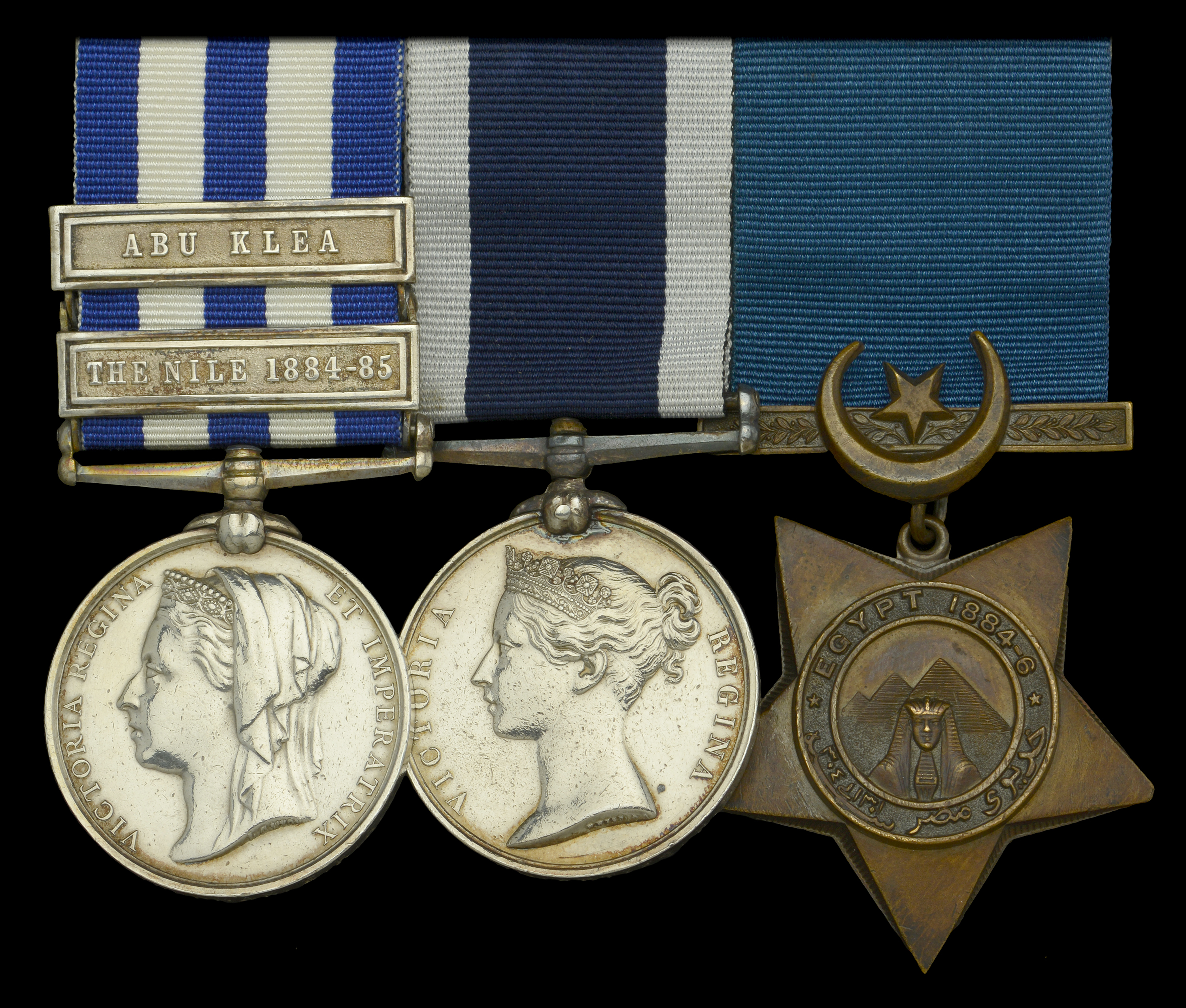The rare Abu Klea group of three awarded to George Holden Woodman, Engine Room Artificer in the Safieh during her epic rescue in February 1885 of Sir Charles Wilson’s ill-fated party on its attempt to reach Khartoum, in the course of which he was severely scalded when the Safieh’s boiler took a direct hit Egypt and Sudan 1882-89, undated reverse, 2 clasps, The Nile 1884-85, Abu Klea (G. Woodman, E.R.A.) impressed naming, engraved correction to initial; Royal Navy L.S. & G.C., V.R., narrow suspension (G. Woodman, Eng. Rm. Artifr., H.M.S. President) impressed naming, engraved correction to initial; Khedive’s Star, dated 1884-6, light pitting from star, otherwise very fine (3) £2,600-£3,000 --- Importation Duty This lot is subject to importation duty of 5% on the hammer price unless exported outside the UK --- --- With small detachments from the naval brigade and with 20 marksmen from the mounted infantry, Charles Beresford began his advance up the river on the steamer Safieh, to rescue Sir Charles Wilson’s party. His armament consisted of two Gardner machine guns and two 4-pounder brass mountain guns. The engine-room staff consisted of Chief Engineer Benbow, two engine-room artifisers, Royal Navy, J. T. Garland and G. Woodman, and one chief stoker, Royal Navy, an Arab engineer and six Soudanese stokers. The Safieh could steam at the rate of some 2.5 knots only; so, even if navigation had been unimpeded, progress would have been extremely slow. Early on 3 February the Safieh sighted the 3-gun Dervish fort at Wad Habeshni, which put a shot into the steamer’s boiler. Between 1900 hours and 2000 hours the Gardner silenced the only Dervish gun that could bring fire upon the steamer after she had anchored on the bank opposite the fort, some 450 metres distant from it. Undoubtedly, this silencing of the fort’s guns saved the steamer from destruction. Wilson’s party slipped past the fort in the darkness, the sick and wounded being transported in a nuggar (which, although fired on, suffered little damage) and the remainder marching along the opposite bank. The enemy were deceived into believing that both the Safieh and the nugger had been abandoned; the result being that the enemy fire ceased for the night. The damaged boiler had cooled by 1100 hours. Chief Engineer Henry Benbow went to work on it as soon as it could be touched, and, after ten hours of unremitting labour, he succeeded in repairing it. “Too much credit,” said Beresford, “cannot be given to this officer, as he had to shape the plate, bore the holes in plate and boiler, and run down the screws and nuts, almost entirely with his own hands, the artificers and everyone in the stokehold having been scalded severely by the explosion when the shot entered the boilers.” Beresford later stated that he would have recommended Benbow for the Victoria Cross but was under the impression that the latter’s service was not of the type that would have qualified for the award. Benbow was later promoted to be Inspector of Machinery. At 0500 hours on 4 February the fires of the boiler were re-lit; every precaution having been taken, however, to raise steam as quietly and unobtrusively as possible. At 0550 hours, when day was about to break and all was ready, the Dervishes realized that the Safieh had not been deserted and brought the guns to bear upon the steamer; but, before they could open fire, Beresford weighed anchor and proceeded up the river, as if steaming for Khartum. He only travelled for some half a kilometre until, finding a place in which he could turn in safety, put about and steamed past the fort at the highest speed possible, using his rifles and machine guns with maximum effect. Below the fort he found the nuggar aground, with the sick and wounded still in her and within range of the Dervish guns. At length both steamer and nuggar were able to move down to the area where Wilson, with his party, were awaiting them. All were taken on board, and at 1745 hours the camp at Gubat - the main base of the relief force at this time - was reached. This episode of the rescue of Wilson’s relief force involved a decisive psychological victory against the Mahdi’s forces at a critical juncture in the fortunes of the desert column. It should be borne in mind that the capture of Khartum had cemented the Mahdi’s control over the entire region. In point of fact, he had despatched an army of some 30,000 men against Gubat. However, the rescue of Wilson’s ill-starred expedition restored British prestige in the eyes of the Dervishes to such an extent that the commander of the latter restrained his forces until the British had quit the neighbourhood of the river. The fact that the extremely vulnerable force at Gubat was not attacked is an indication of the extent of Beresford’s psychological victory. George Holden Woodman was born at Horley, Surrey, on 2 April 1853, and joined the Royal Navy on 1 April 1878, aged 25, a fitter by trade. Rated Acting Engine Room Artificer he joined H.M.S. Pembroke, the newly commissioned Royal Navy Supply School at Chatham. Brief service aboard Monarch and Devastation was followed by his appointment to the Falcon in July 1878, in which ship he was confirmed as E.R.A. in August 1879. He moved to Royal Adelaide in October 1881 and the following month returned to Pembroke. Thereafter he served ashore at Duncan, Pembroke, Vernon and Pembroke again until joining Monarch in September 1884 and his attachment to the Nile Flotilla from October 1884 to April 1885. He received his L.S. & G.C. medal in May 1886, and promotion to E.R.A. 1st Class on 1 April 1888, and to Chief E.R.A. 2nd Class later in the same month. He was advanced to Chief E.R.A. 1st Class in April 1894, and ended his days at President (R.N. College) from May 1896 to 30 April 1900, when he was shore pensioned. Sold with copied record of service and medal roll confirmation, together with an original edition of Nash’s Magazine for May 1914, with Admiral Beresford’s own account of the Safieh’s adventures in ‘Running the Gauntlet’ which mentions Woodman’s presence on board.





